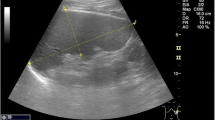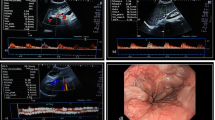Abstract
Background: Compared with esophageal varices, gastrointestinal varices are relatively rare, but they are clinically important because they tend to bleed massively. Color Doppler sonography is now widely used to diagnose the collaterals, but few color Doppler findings of gastric or intestinal varices have been reported. The aim of this study was to investigate the sonographic and color Doppler findings of gastrointestinal varices and to determine the role of color Doppler sonography in the diagnosis of these varices.
Methods: We studied 30 patients who were diagnosed by endoscopy as having gastrointestinal varices (24 gastric, four duodenal, two intestinal) with color Doppler sonography and compared the results with the clinical data. The causes of gastric varices included liver cirrhosis (16/24, 66.7%), idiopathic portal hypertension (3/24, 12.5%), chronic pancreatitis with splenic vein thrombosis (2/24, 8.3%), congenital biliary atresia (1/24, 4.2%), congenital hepatic fibrosis (1/24, 4.2%), and unknown (1/24, 4.2%). The causes of duodenal varices included idiopathic portal hypertension with portal thrombosis (3/4, 75%) and liver cirrhosis (1/4, 25%).
Results: The gastric wall at the fundus was thickened in 17 of 24 cases (70.8%) with gastric varices, and the duodenal wall was thickened in four of four cases (100%) with duodenal varices. Sonography revealed thrombosis in the splenic vein in two of two cases with gastric varices secondary to chronic pancreatitis and in the confluence of the superior mesenteric vein and the splenic vein in three of four cases with duodenal varices. Color Doppler sonography demonstrated multiple, slow constant blood flows in the thickened wall in 15 of 24 cases (62.5%) with gastric varices and in four of four cases (100%) with duodenal varices. It demonstrated accumulated slow constant blood flows in the cecum in the case with cecal varices. Color Doppler showed also the communication between the varices and the neighboring vascular system (superior mesenteric vein and inferior vena cava) in the case with cecal varices, but it did not directly reveal such a communication in the other 29 cases (96.7%). Color Doppler showed a hepatofugal flow in the left gastric vein in all the hemorrhagic gastric varicose patients with esophageal varices, but it showed a hepatopetal flow in the left gastric vein in the isolated nonhemorrhagic gastric varicose patients.
Conclusion: Color Doppler sonography was very useful for the diagnosis of gastric and duodenal varices and for visualizing fine venous flows in the thickened gastric or duodenal wall. When it shows portal thrombosis in the confluence of the splenic vein and the superior mesenteric vein, duodenal varices should be suspected. The flow direction of the left gastric vein helps to differentiate hemorrhagic gastric varices from nonhemorrhagic ones.
Similar content being viewed by others
Author information
Authors and Affiliations
Additional information
Received: 2/26/96/Accepted after revision: 7/24/96
Rights and permissions
About this article
Cite this article
Komatsuda, T., Ishida, H., Konno, K. et al. Color Doppler findings of gastrointestinal varices. Abdom Imaging 23, 45–50 (1998). https://doi.org/10.1007/s002619900283
Published:
Issue Date:
DOI: https://doi.org/10.1007/s002619900283




